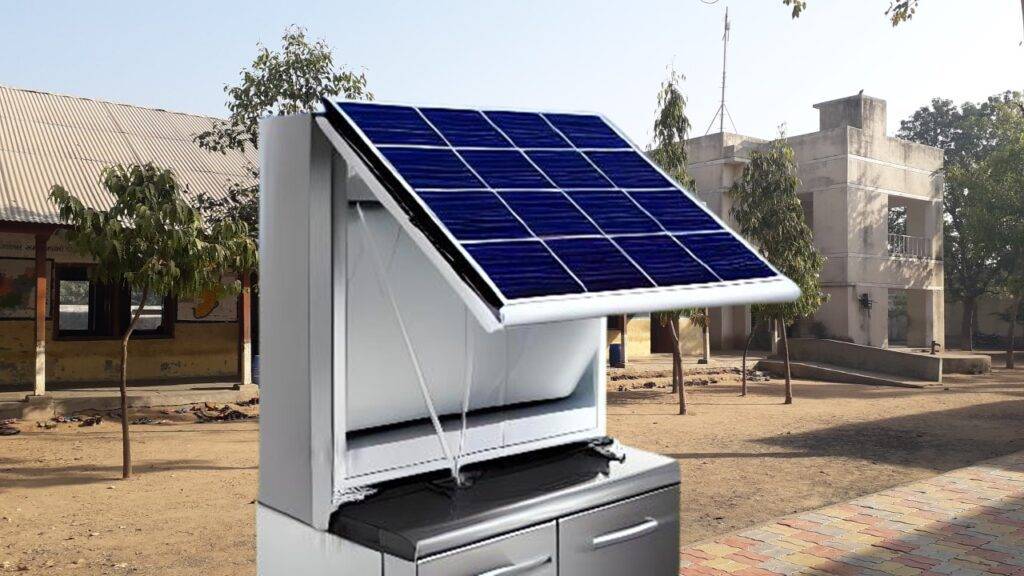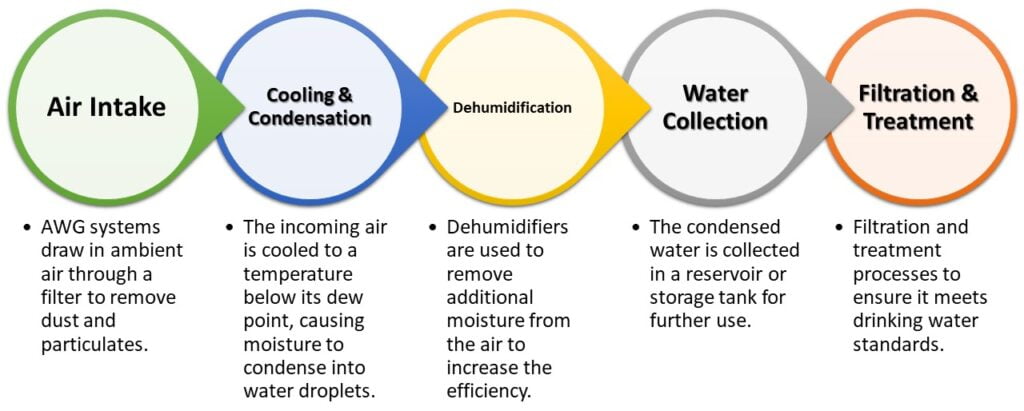
Water scarcity is a growing concern around the world, and many regions are facing water stress. In response, researchers are exploring alternative sources of freshwater, such as atmospheric water generators. These devices collect water from the air using special technology and can provide an alternate source of freshwater. There are a number of question that arises with the development and advancement of the Atmospheric Water Generation (AWG) system. For example, what are the environmental impacts of AWG? Is it cost-effective? Is the generation of water from the air bad for the environment? To get the answer to these questions let’s understand the process, cost-benefit analysis and its impact on the environment.
1. What is an Atmospheric Water Generator (AWG)?
Atmospheric Water Generation (AWG) technology is a method of extracting moisture from the air to produce clean and potable water. It has gained attention as a sustainable and innovative solution to address water scarcity issues in various parts of the world. AWG systems work on the principle of condensation. They use a combination of cooling and dehumidification processes to convert water vapour in the air into liquid water. This water is then collected, treated, and made available for various uses.

Components of AWG Systems
- Air Intake: AWG systems draw in ambient air through a filter to remove dust and particulates.
- Cooling and Condensation: The incoming air is cooled to a temperature below its dew point, causing moisture to condense into water droplets.
- Dehumidification: Dehumidifiers are useful to remove additional moisture from the air, increasing water production efficiency.
- Water Collection: The condensed water is collected in a reservoir or storage tank.
- Filtration and Treatment: The collected water may undergo filtration and treatment processes to ensure it meets drinking water standards.
The energy required for cooling and dehumidification can be supplied by various sources, such as electricity, solar power, or waste heat from other processes. The choice of energy source significantly impacts the environmental footprint and efficiency of the AWG system. AWG systems are designed in a range of sizes, from compact, portable units capable of producing a few litres of water per day to large-scale installations that can produce thousands of litres daily. This scalability renders AWG suitable for both individual and community-level applications.
AWG offers a dependable source of clean drinking water in regions with limited access to fresh water. In addition, it can be highly useful for irrigation in agriculture, especially in arid regions. AWG systems can also be useful in disaster-stricken areas to swiftly provide a sustainable source of drinking water. In addition, industries can utilize AWG technology to meet their water requirements, reducing dependence on conventional water sources.
2. Environmental benefits and cost-effectiveness of AWG
AWG systems can reduce the environmental impact of water sourcing by providing a sustainable and energy-efficient way to produce clean water. They can be particularly cost-effective in regions with water scarcity, where traditional water sources may be a limitation or expensive to access. Additionally, as AWG technology continues to advance, it holds the potential to further improve both its environmental performance and cost-effectiveness, making it a promising solution for addressing water-related challenges.
Key benefits and effectiveness
- When powered by renewable energy sources such as solar or wind, AWG systems become environmentally friendly, as they diminish the need for water transportation and minimize carbon emissions linked to water production and distribution.
- The generation of water by AWG systems is of high quality, as it undergoes filtration and treatment processes. However, the cleanliness of the air from which water is harvested can impact water quality, so air quality monitoring may be necessary.
- Challenges encompass the high energy consumption of certain AWG systems, the necessity for suitable humidity levels in the air, and potential air quality concerns in polluted areas. A recent study published in the journal Case Studies in Chemical and Environmental Engineering analyzed the performance of an atmospheric water generator under hot and humid conditions. The study found that the device requires 0.6 kWh of energy per litre of water produced.
- The performance of the AWG system significantly varies by the change in temperature and humidity of the air. In hot and dry conditions, the system is less efficient at extracting water from the air.
- According to a recent study, the cost of water production varies from 0.07$ to 0.28$ per litre. The annual average water production cost is 0.18$ per litre over the year. Additionally, the initial cost of AWG systems can serve as a barrier to adoption. However, integrating renewable energy sources such as solar PV, as a driving force for AWG can make them more economical, sustainable, and environmentally friendly. It’s worth noting that the energy consumption of AWG can have an impact on the environment.
3. What is a solar-powered AWG system?
Solar-powered Atmospheric Water Generation (AWG) systems combine the principles of AWG technology with solar energy to produce clean and potable water using renewable power sources. These systems are designed to operate in regions with ample sunlight and are known for their sustainability and environmentally friendly characteristics.
Solar-powered AWG systems use photovoltaic (PV) panels to convert sunlight into electricity. This electricity is then useful to run the cooling and dehumidification processes required for water generation. By relying on solar energy, these systems reduce their dependence on non-renewable energy sources, making them more eco-friendly. This system is useful in off-grid or remote areas where access to a centralized power grid is a limitation or non-existent. These systems can operate independently, which makes them particularly valuable for providing clean water in rural and underserved communities.
Solar energy is a sustainable and renewable resource, which means that solar-powered AWG systems have a lower environmental footprint compared to systems powered by fossil fuels or grid electricity. Therefore, it can produce clean water without contributing to greenhouse gas emissions. However, solar-powered AWG systems require regular maintenance to ensure the efficient operation of both the solar panels and the AWG components. This includes cleaning and monitoring to maximize water production.
While solar-powered AWG systems offer long-term cost savings by reducing water transportation expenses, the initial installation costs, including solar panels and AWG equipment, can be relatively high. However, over time, these systems can provide a cost-effective solution for clean water provision, particularly in remote regions.
4. Environmental Impacts of AWG
As compared to many other water sources, the generation of water from air is environmentally friendly. However, the environmental impacts of AWG can vary depending on various factors.
- Energy Source: AWG’s environmental impact hinges on its energy source. Renewable sources like solar, wind, or hydropower yield minimal carbon emissions, making them eco-friendly. Non-renewable sources like fossil fuels increase carbon footprint, but efficiency and carbon offset measures can help mitigate this.
- Location: AWG effectiveness varies by location. In arid regions, it’s sustainable, reducing long-distance water transport. In water-rich areas, AWG may be less environmentally advantageous.
- Air Quality: Air quality affects AWG’s environmental impact. In polluted regions, harvested water may contain contaminants, necessitating extra purification.
- Materials and Maintenance: AWG system production and upkeep can use materials with environmental consequences. Sustainable materials and responsible manufacturing practices help minimize these impacts.
- Disposal and Waste Management: Proper disposal of waste products, like filters and maintenance materials, is vital to prevent environmental harm.
- Comparisons to Alternatives: AWG’s environmental impact should be relative to other water sources. It may have a lower impact than energy-intensive desalination or long-distance water transport in some cases.
- Local Ecosystem: AWG systems must be designed with local ecosystems in mind, especially in sensitive areas. Water extraction should not harm local wildlife or the environment.
5. Locations where AWG is successful
AWG has been successfully implemented in various locations around the world to address water scarcity and provide clean drinking water. Example of successful implementation:
- Arabian Gulf Countries: The United Arab Emirates, Qatar, and Saudi Arabia have implemented AWG technology to supplement their freshwater supply in arid desert regions.
- Island Nations: Maldives is using AWG systems to generate clean drinking water for their residents and tourists.
- California, USA: California, known for its periodic droughts, has seen the deployment of AWG systems in homes, businesses, and public buildings.
- Africa: Watergen, an Israeli company, has partnered with organizations to provide AWG solutions in places like South Africa and Nigeria to address water challenges.
- India: India, with its diverse climate and water challenges, has also embraced AWG technology. AWG systems are mostly useful in rural areas and urban centres to provide clean drinking water and improve water access.
- Disaster Relief: Humanitarian organizations and governments use portable AWG units to quickly supply clean water in the aftermath of natural disasters such as hurricanes, earthquakes, and floods.
- Military and Defense: AWG technology is useful for the military to ensure a reliable source of clean water for troops deployed in remote and challenging environments.
- Remote Communities: AWG is particularly valuable in remote and off-grid communities where traditional water infrastructure is impractical. These systems are highly useful to provide clean water for drinking, cooking, and sanitation.
- Greenhouses and Agriculture: AWG aids irrigation in water-scarce regions
- Hotels and Resorts: Luxury hotels and resorts in water-scarce areas have implemented AWG systems to provide guests with a sustainable and reliable source of clean drinking water.
It’s important to note that the success of AWG implementation depends on various factors, including the local climate, energy sources, system design, and community needs.
6. What are the challenges of AWG?
While AWG technology offers numerous benefits with a number of environmental impacts, it also faces several challenges that can affect its widespread adoption and effectiveness. Here are the list of key challenges:
- Energy Consumption: Cooling and dehumidification processes require power, and the source of this energy can impact the environmental sustainability of the technology. High energy consumption can also be a limiting factor in areas with unreliable or expensive electricity.
- Climate Dependence: The local climate conditions, particularly humidity levels highly affect the efficiency of AWG systems. In arid regions with extremely low humidity, AWG may not be a viable option, as it becomes less efficient. Conversely, high-humidity areas are more suitable for AWG.
- Initial Cost: The upfront cost of purchasing and installing AWG systems can be relatively high. This cost can be a barrier to adoption.
- Maintenance and Repairs: AWG units require regular maintenance to ensure optimal performance. Filters, condenser coils, and other components need cleaning or replacement over time. Maintenance can be costly and challenging in remote or underserved areas.
- Air Quality: The quality of harvested water highly depends on the quality of the air. In areas with high levels of air pollution, AWG systems may require additional filtration and treatment to remove contaminants from the harvested water.
- Water Purity: While AWG systems generally produce high-quality water, the purity of the water can vary depending on the system’s design and maintenance.
- Scale and Efficiency: Scaling AWG technology to meet the water needs of large populations or industries can be challenging. Efficiency and scalability depend on system design and available resources, making it important to tailor AWG solutions to specific applications.
Conclusion
AWG technology offers a promising solution for addressing water scarcity, despite various challenges and a number of environmental impacts. However, its environmental impact varies but can be eco-friendly with responsible implementation. With ongoing advancements and a focus on sustainability, AWG systems continue to be a valuable tool in ensuring access to clean water in water-stressed regions.

